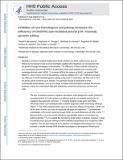| dc.contributor.author | Maruyama, Takeshi | |
| dc.contributor.author | Dougan, Stephanie K | |
| dc.contributor.author | Truttmann, Matthias C | |
| dc.contributor.author | Bilate, Angelina M | |
| dc.contributor.author | Ingram, Jessica R | |
| dc.contributor.author | Ploegh, Hidde | |
| dc.date.accessioned | 2017-01-06T14:34:36Z | |
| dc.date.available | 2017-01-06T14:34:36Z | |
| dc.date.issued | 2015-03 | |
| dc.date.submitted | 2014-07 | |
| dc.identifier.issn | 1087-0156 | |
| dc.identifier.issn | 1546-1696 | |
| dc.identifier.uri | http://hdl.handle.net/1721.1/106223 | |
| dc.description.abstract | Methods to introduce targeted double-strand breaks (DSBs) into DNA enable precise genome editing by increasing the rate at which externally supplied DNA fragments are incorporated into the genome through homologous recombination. The efficiency of these methods is limited by nonhomologous end joining (NHEJ), an alternative DNA repair pathway that competes with homology-directed repair (HDR). To promote HDR at the expense of NHEJ, we targeted DNA ligase IV, a key enzyme in the NHEJ pathway, using the inhibitor Scr7. Scr7 treatment increased the efficiency of HDR-mediated genome editing, using Cas9 in mammalian cell lines and in mice for all four genes examined, up to 19-fold. This approach should be applicable to other customizable endonucleases, such as zinc finger nucleases and transcription activator–like effector nucleases, and to nonmammalian cells with sufficiently conserved mechanisms of NHEJ and HDR. | en_US |
| dc.description.sponsorship | National Institutes of Health (U.S.) (RO1 Grant AI087879-01) | en_US |
| dc.description.sponsorship | Pancreatic Cancer Action Network | en_US |
| dc.language.iso | en_US | |
| dc.publisher | Nature Publishing Group | en_US |
| dc.relation.isversionof | http://dx.doi.org/10.1038/nbt.3190 | en_US |
| dc.rights | Article is made available in accordance with the publisher's policy and may be subject to US copyright law. Please refer to the publisher's site for terms of use. | en_US |
| dc.source | PMC | en_US |
| dc.title | Increasing the efficiency of precise genome editing with CRISPR-Cas9 by inhibition of nonhomologous end joining | en_US |
| dc.type | Article | en_US |
| dc.identifier.citation | Maruyama, Takeshi et al. “Increasing the Efficiency of Precise Genome Editing with CRISPR-Cas9 by Inhibition of Nonhomologous End Joining.” Nature Biotechnology 33.5 (2015): 538–542. | en_US |
| dc.contributor.department | Massachusetts Institute of Technology. Department of Biology | en_US |
| dc.contributor.department | Whitehead Institute for Biomedical Research | en_US |
| dc.contributor.mitauthor | Ploegh, Hidde | |
| dc.relation.journal | Nature Biotechnology | en_US |
| dc.eprint.version | Author's final manuscript | en_US |
| dc.type.uri | http://purl.org/eprint/type/JournalArticle | en_US |
| eprint.status | http://purl.org/eprint/status/PeerReviewed | en_US |
| dspace.orderedauthors | Maruyama, Takeshi; Dougan, Stephanie K; Truttmann, Matthias C; Bilate, Angelina M; Ingram, Jessica R; Ploegh, Hidde L | en_US |
| dspace.embargo.terms | N | en_US |
| dc.identifier.orcid | https://orcid.org/0000-0002-1090-6071 | |
| mit.license | PUBLISHER_POLICY | en_US |
| mit.metadata.status | Complete | |
